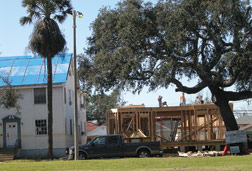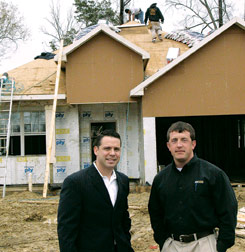 Angelle Bergeron/ENR Piecemeal housing development is more traditional in the area because of limited lot availability.
|
More than a year after Hurricane Katrina, troubling questions still remain about the wisdom of building in parts of New Orleans and the city’s ability to sustain jobs and economic growth. A recent failed housing megaproject there provides some insight into the problems, but many other project opportunities are popping up.
The 3,000-acre Churchill Farms development on the city’s west bank was to have been New Orleans’ first mega-housing project since Katrina ripped up the city in August 2005. With potentially thousands of homes, the development was proposed by KB/Shaw Louisiana LLC, a joint venture of giant homebuilder KB Home, Los Angeles, and big industrial contractor Shaw Group Inc., Baton Rouge.
The project was intended to help with the recovery of the city and to create work for the firms over the next few years, according to statements made in December 2005 by KB Home Chairman and CEO Bruce Karatz. A year later, that dream was dead. Karatz, a principal cheerleader for the project, was forced out because of a stock options scandal.
But there were other problems. Jon W. Luther, executive vice president of Homebuilders Association of Greater New Orleans, Metairie, thinks the KB/Shaw deal came apart due to national market conditions, primarily falling homebuilder stock prices and resulting loss of liquidity. After developer due diligence, “the finances were not making sense,” he says. “The national market is slowing down and they weren’t particularly satisfied with the job growth around the project and determined that too many units might not be prudent.”
Luther notes that all builders in the region are experiencing some new hurdles, such as an upgraded and uniform statewide building code—International Residential Code 2006—adopted after Katrina. In some areas it established a code for the first time. The Federal Emergency Management Agency’s new base elevation rule also requires some houses to be raised 3 ft from the highest adjacent grade, which increases costs.
“Construction costs are up at least 15%, and for high-volume builders such as KB, it may move them out of their desirable price points,” says Luther. “We also have to deal with material and labor shortages and material price fluctuations, which change daily.”
 Angelle Bergeron/ENR Hard-to-find craft labor and subcontractors is keeping some builders out of the area.
|
Challenges
Repeat flooding remains on everyone’s mind. “I personally looked at property development,” says Bryce Murray, a labor and employment attorney with Taggart Morton LLC, New Orleans. “A few friends and I pooled our money and looked at buying 40 houses in Saint Bernard and putting in an affordable home development. But who says Saint Bernard won’t flood again? The uncertainty is still there no matter what the different agencies say.”
Wade R. Ragas, president of Real Property Associates, Metairie, a commercial market studies firm, says that over 250,000 houses were damaged in the New Orleans metropolitan area. Of those, 100,000 units were so severely damaged that rebuilding is unlikely. “We’ve lost about 270,000 people in the metro area but about 23,000 just moved up the road to Baton Rouge, which means they still do business and have jobs here,” says Ragas. He notes that the net decline in jobs in the area is about 120,000 or about 20%. “The economy is strong because of the rebuilding activity but it is rebuilding for a metro that is only about 80% of its former size,” he says.
 Angelle Bergeron/ENR KB�s Szubinski (left) and project manager Cody Thompson have projects moving in Louisiana.
|
Clint Szubinski, president of KB’s new Gulf Coast region, points to the widespread job loss and population shift as top components that make building in New Orleans a challenge. But he also cites people’s desire to rebuild damaged homes, rather than buy new construction as a major obstacle to large-scale development. “New Orleans is an indigenous city,” Szubinski says. “Most people from New Orleans would rather rebuild on their lot than move to a new location.”
City officials reportedly are working on plans for lot swaps to lure people to more developable areas, but officials did not return repeated phone calls.
Other problems include unresolved insurance claims issues, “horrendous” insurance rates and “strained” permitting processes, Szubinski says. Increases in builders risk aren’t as big a problem for large builders, like KB, that draw from a...

Post a comment to this article
Report Abusive Comment